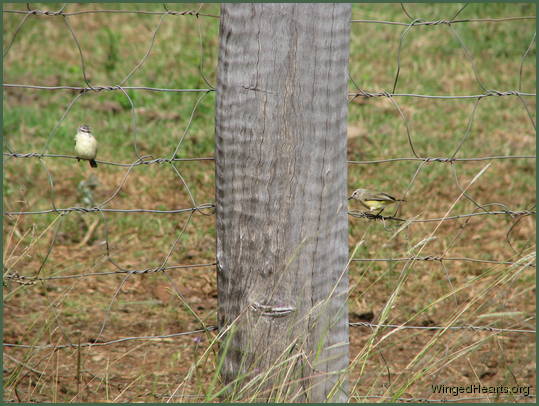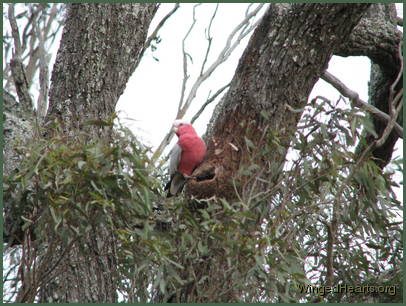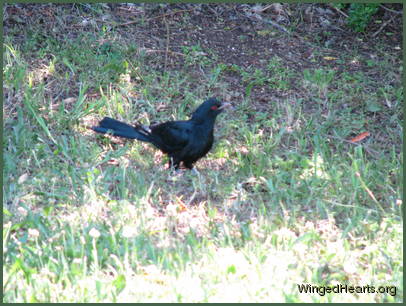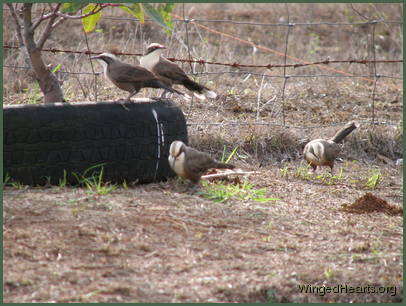Submitted by Gitie on 14 June, 2010 - 00:11
Today we continue to look at the key features that enable us to recognise individual birds.
Once our eyes get used to the differences in the shapes and sizes of the birds in a species. We can start training ourselves to look for more distinguishing characteristics.
- Look at the top of their heads? Does the bird have a smooth or fuzzy head? Is it more round or slightly flat?
- Does the bird have a crest, if so how big is it?
- Then look at their shape of the wings. Do they sag or are they folded tightly?

- Does the right wing cross over the left, or the other way round or do they meet nicely in the centre?
- Look at the patterns of colour around their faces, necks, chests, backs, legs and wings. In the examples below you will see the shapes are different for each bird, even though at first glance the birds appear to be similar.
- How long is their beak? What is the shape of their mouths?
- Do they have any distinguishing parks on their beaks and cheeks?
In the picture on the right (above), the shape of the mask around the eyes, under the chin as well as the marks where the beaks
meet the cheek are all individual characteristics. Renutu (noisy-miner) does not have a goatie in the centre of his mask unlike his sister Chipkin in the picture below.

Submitted by Gitie on 12 June, 2010 - 00:14

Thornbills (or yellow bottoms as they are fondly called) are barely 5 cms (2 inches) long. The picture on the left was taken with a 300mm zoom. Then the image was digitally enlarged. You get the idea of how small these birds really are against objects in their natural environment.
They first attracted our attention when we were trying to photograph some peewees in a paddock. What appeared to be leaves rolling

Submitted by Gitie on 11 June, 2010 - 00:00

Galahs are also called rose-breasted cockatoos and can be found almost all over Australia. With pretty pink chests and grey coats they strike a stylish figure as they strut about the gum trees. They fly around in pairs and collect in flocks and are extremely social birds.
'Mad as a galah' is a common Aussie saying which probably originated from the fact that they can make loud screechy noises if upset and once they get into this whining state it can take quite a while to calm them down.
There was a time when I too thought they were somewhat crazy. Every night when we took our dogs Scotty and Benny for a walk, one particular galah who should have been fast asleep in his tree high above us and in no danger whatsoever from anything around, would start screeching and wake up the whole neighbourhood in the process.
But Galahs are far from mad. They are very friendly birds. They love showing you their nests and introducing you to their friends and family.

Submitted by Gitie on 8 June, 2010 - 00:00
|

Koels herald the start of the stormy season and are called 'storm birds' by the locals.
While as big as a crow or a currawong, by nature they are shy birds and tend to stay in hiding. Their red eyes match the mulberries in the tree and when they sit in the shade of the broad leaves, one would never guess that there was a big bird sitting only a few feet away.
All the other birds are generally wary of cuckoos as they sense that someone devious is lurking in their midst. The koels know that they are not popular, but they do win favours by chasing the goannas and feral cats thus making friends and gaining the trust with some of the other birds.
Having done so this male koel (left) was allowed to come out of hiding without any protest from the smaller birds that visit our yard. His mind and heart was elsewhere though as we discovered.
|
 In the trees was hiding another male koel whose presence was causing him great consternation. In the trees was hiding another male koel whose presence was causing him great consternation. |
|

It turned out that the tree was hiding another secret. Closer inspection revealed a young female koel who was the centre of attention of the two vying young males. The lady honoured us by coming out after some gentle coaxing and sweet talking.
Her two suitors spent the next few days charming and courting her with their songs. Once she declared her choice they flew into the deep bush leaving one lonely bird who called for weeks. We hope he found his sweetheart too.
Click here for more pics and slideshow
|

Submitted by Gitie on 7 June, 2010 - 17:44
 Babblers although larger than noisy-miners are still small, gentle birds that can be easily preyed upon by hawks and other predators. They stay in their family groups, constantly moving and flitting about so as to confuse any hungry eyes watching them with the wrong intentions. They are generally very shy and quite nervous birds and don't project the immense self-confidence that we've seen in quails for instance.
Babblers although larger than noisy-miners are still small, gentle birds that can be easily preyed upon by hawks and other predators. They stay in their family groups, constantly moving and flitting about so as to confuse any hungry eyes watching them with the wrong intentions. They are generally very shy and quite nervous birds and don't project the immense self-confidence that we've seen in quails for instance.
They like hovering in muddy patches, or near gravel, stone, logs and barks looking for insects.
We noticed their friendship with the magpies soon after we became friends with Maggie and his sisters Cindy and Tammie.

Pages





 In the trees was hiding another male koel whose presence was causing him great consternation.
In the trees was hiding another male koel whose presence was causing him great consternation.





